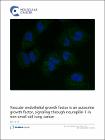| dc.contributor.author | GATELY, KATHY | en |
| dc.contributor.author | O'BYRNE, KEN | en |
| dc.contributor.author | PIDGEON, GRAHAM | en |
| dc.contributor.author | GRAY, STEVEN | en |
| dc.date.accessioned | 2015-12-09T12:27:24Z | |
| dc.date.available | 2015-12-09T12:27:24Z | |
| dc.date.issued | 2015 | en |
| dc.date.submitted | 2015 | en |
| dc.identifier.citation | Barr, M.P., Gray, S.G., Gately, K., (...), Pidgeon, G.P., O'Byrne, K.J., Vascular endothelial growth factor is an autocrine growth factor, signaling through neuropilin-1 in non-small cell lung cancer, Molecular Cancer, 14, 1, 2015, 45- | en |
| dc.identifier.other | Y | en |
| dc.identifier.uri | http://hdl.handle.net/2262/75208 | |
| dc.description | PUBLISHED | en |
| dc.description.abstract | Background: The VEGF pathway has become an important therapeutic target in lung cancer, where VEGF has long been established as a potent pro-angiogenic growth factor expressed by many types of tumors. While Bevacizumab (Avastin) has proven successful in increasing the objective tumor response rate and in prolonging progression and overall survival in patients with NSCLC, the survival benefit is however relatively short and the majority of patients eventually relapse. The current use of tyrosine kinase inhibitors alone and in combination with chemotherapy has been underwhelming, highlighting an urgent need for new targeted therapies. In this study, we examined the mechanisms of VEGF-mediated survival in NSCLC cells and the role of the Neuropilin receptors in this process. Methods: NSCLC cells were screened for expression of VEGF and its receptors. The effects of recombinant VEGF and its blockade on lung tumor cell proliferation and cell cycle were examined. Phosphorylation of Akt and Erk1/2 proteins was examined by high content analysis and confocal microscopy. The effects of silencing VEGF on cell proliferation and survival signaling were also assessed. A Neuropilin-1 stable-transfected cell line was generated. Cell growth characteristics in addition to pAkt and pErk1/2 signaling were studied in response to VEGF and its blockade. Tumor growth studies were carried out in nude mice following subcutaneous injection of NP1 over-expressing cells. Results: Inhibition of the VEGF pathway with anti-VEGF and anti-VEGFR-2 antibodies or siRNA to VEGF, NP1 and NP2 resulted in growth inhibition of NP1 positive tumor cell lines associated with down-regulation of PI3K and MAPK kinase signaling. Stable transfection of NP1 negative cells with NP1 induced proliferation in vitro, which was further enhanced by exogenous VEGF. In vivo, NP1 over-expressing cells significantly increased tumor growth in xenografts compared to controls. Conclusions: Our data demonstrate that VEGF is an autocrine growth factor in NSCLC signaling, at least in part, through NP1. Targeting this VEGF receptor may offer potential as a novel therapeutic approach and also support the evaluation of the role of NP1 as a biomarker predicting sensitivity or resistance to VEGF and VEGFR-targeted therapies in the clinical arena. | en |
| dc.format.extent | 45 | en |
| dc.relation.ispartofseries | Molecular Cancer | en |
| dc.relation.ispartofseries | 14 | en |
| dc.relation.ispartofseries | 1 | en |
| dc.rights | Y | en |
| dc.subject | Cell signaling; Neuropilins; NSCLC; Survival; VEGF | en |
| dc.subject.lcsh | Cell signaling; Neuropilins; NSCLC; Survival; VEGF | en |
| dc.title | Vascular endothelial growth factor is an autocrine growth factor, signaling through neuropilin-1 in non-small cell lung cancer | en |
| dc.type | Journal Article | en |
| dc.type.supercollection | scholarly_publications | en |
| dc.type.supercollection | refereed_publications | en |
| dc.identifier.peoplefinderurl | http://people.tcd.ie/watsong | en |
| dc.identifier.peoplefinderurl | http://people.tcd.ie/obyrneke | en |
| dc.identifier.peoplefinderurl | http://people.tcd.ie/pidgeong | en |
| dc.identifier.peoplefinderurl | http://people.tcd.ie/gatelyk | en |
| dc.identifier.peoplefinderurl | http://people.tcd.ie/grayst | en |
| dc.identifier.rssinternalid | 105233 | en |
| dc.identifier.doi | http://dx.doi.org/10.1186/s12943-015-0310-8 | en |
| dc.rights.ecaccessrights | openAccess | |
| dc.identifier.orcid_id | 0000-0001-6732-9474 | en |




